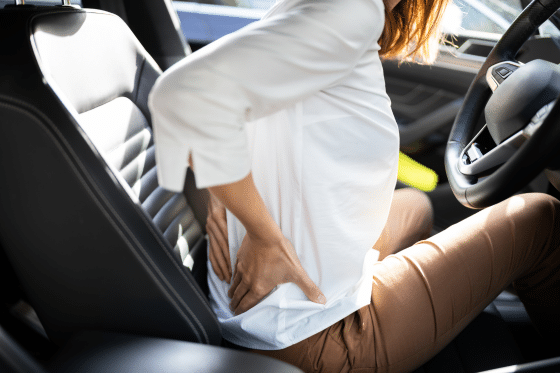TL;DR: Prolonged sitting increases the risk of back pain and discomfort by placing sustained load on spinal structures, weakening postural muscles, and reducing circulation. Older adults are especially vulnerable. Practical steps — ergonomic adjustments, regular microbreaks, gentle strengthening and mobility exercises, and professional advice when pain is persistent or severe — can reduce symptoms and protect long‑term back health.12
Why this matters for older adults
As we age, changes in muscle mass, bone density and joint mobility make the spine less resilient to sustained positions. The same period of sitting that was once tolerated may begin to produce stiffness and discomfort in the lower back and surrounding areas.
Because older adults may already have degenerative changes (for example, osteoarthritis or disc wear), prolonged sitting can magnify symptoms and reduce function over time.3
How sitting affects the back — the key mechanisms
Sustained mechanical load on spinal structures
Sitting changes the distribution of forces across the spine. Slumped or unsupported sitting increases pressure on intervertebral discs and posterior spinal tissues, which can contribute to pain and stiffness.
Repeated or prolonged loading without movement limits the spine’s ability to recover between stress cycles.
Reduced activity of postural muscles
Long periods of sitting mean the deep stabilising muscles around the lumbar spine (such as the multifidus and transversus abdominis) work less. Over time they can lose tone and endurance, reducing dynamic support for the spine.
This muscle deconditioning can make minor stresses feel more painful and slow recovery from back episodes.
Shortened soft tissues and altered mobility
Hip flexors and hamstrings often shorten with prolonged sitting. Tight hips increase lumbar spine movement and can change posture, which contributes to discomfort and functional decline.
Poor circulation and increased stiffness
Sitting for extended periods reduces blood flow to muscles and connective tissues. Reduced circulation contributes to stiffness and can make recovery slower after activity.
What the evidence says
Low back pain is the single leading cause of years lived with disability worldwide, and sedentary behaviour is one of several contributing factors to musculoskeletal health in adults.1
Public health guidance recommends reducing sedentary time and breaking up long sitting periods with movement, because replacing sitting time with light activity improves multiple health outcomes. The evidence directly linking sitting to back pain is mixed but growing; many guidelines nevertheless advise regular movement to reduce discomfort and maintain function.24
Practical, evidence‑based steps to protect your back
1. Make your seating supportive
- Choose a chair with good lumbar support or add a lumbar roll to preserve the natural curve of the lower back.
- Keep hips and knees at roughly the same level and feet supported on the floor or a footrest.
2. Break sitting into manageable segments
Avoid uninterrupted sitting for long periods. Aim to stand or move for 1–2 minutes every 20–30 minutes, and take a 5–10 minute walk each hour when possible.
Interrupting sitting with brief movement has demonstrated benefits for metabolic health and may reduce stiffness and discomfort; evidence for back‑specific outcomes is promising but still developing.5
3. Add gentle mobility and strengthening
- Practice seated or standing mobility: gentle spinal rotations, pelvic tilts and hip circles to reduce stiffness.
- Perform simple strength exercises for core and hip muscles — for example, seated marches, wall squats, and bridges — adapted to ability and balance. These help support the spine and reduce load.
Start slowly and increase frequency rather than intensity. If you have balance or cardiovascular concerns, check with your clinician before starting new exercises.
4. Use task and environment strategies
- Raise reading materials to eye level to avoid forward head posture.
- Alternate between sitting and standing tasks where possible (phone calls, simple chores).
- Consider a sit‑stand workstation or a seated cushion to alter pressure points across the day.
5. Manage pain safely and seek help when needed
For mild, short‑lived discomfort, the above strategies often help. If pain is severe, progressive, associated with numbness, weakness, unexplained weight loss, or bowel/bladder changes, seek prompt medical assessment.
A physiotherapist can provide a personalised assessment, teach exercises, and guide an ergonomic plan suited to your health status and lifestyle.
Simple routine to reduce back discomfort while seated (for older adults)
This routine focuses on mobility and gentle activation. Perform each item slowly and within a comfortable range.
- Seated pelvic tilts — 10 repetitions: gently rock pelvis forward and back while keeping feet on the floor.
- Seated marches — 30 seconds: lift one knee a few inches then the other, keeping core engaged.
- Hip flexor stretch (standing support if needed) — 20–30 seconds per side.
- Thoracic rotation — 8–10 reps per side: sit tall, twist gently from the upper back with hands on knees.
- Stand and walk for 2–5 minutes after finishing the set.
Repeat every 60 minutes during prolonged sitting. Modify frequency based on tolerance and endurance.
Special considerations for older adults
Balance, joint replacement, osteoporosis and cardiovascular conditions can affect which strategies are safe. Use supportive shoes, stable surfaces, and a chair with arms for standing up and sitting down.
If you have osteoporosis, avoid sudden flexion movements and seek a clinician’s guidance about safe exercises. A tailored programme from a physiotherapist reduces risk and improves outcomes.
When to get professional help
See a healthcare professional if you experience increasing pain, symptoms that do not improve with conservative measures after a few weeks, or any neurological signs (numbness, tingling, weakness). Early assessment helps rule out red flags and creates a specific plan for recovery.
Click here to book your free discovery visit with us! – Free Discovery Visit – Paul Gough Physio Rooms


